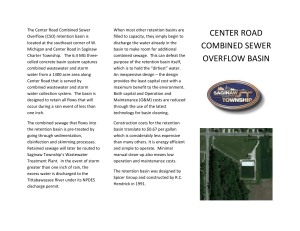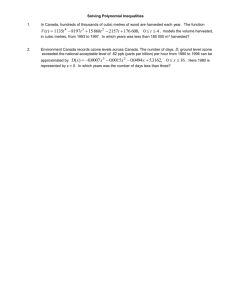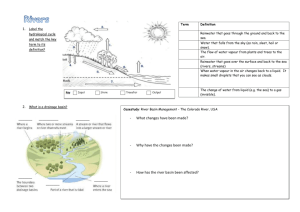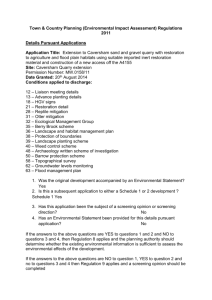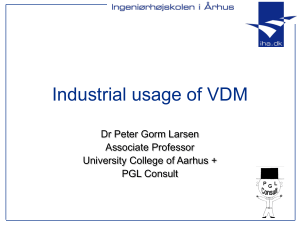Rainwater harvesting as a tool to protect vulnerable ecosystems
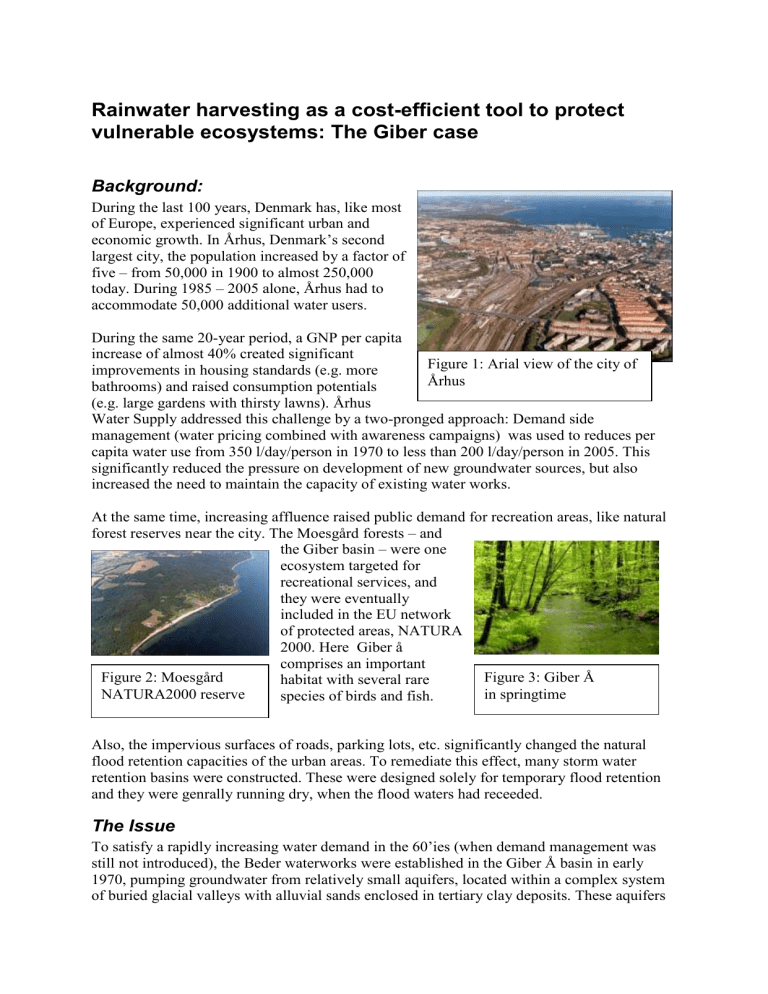
Rainwater harvesting as a cost-efficient tool to protect vulnerable ecosystems: The Giber case
Background:
During the last 100 years, Denmark has, like most of Europe, experienced significant urban and economic growth. In Århus, Denmark’s second largest city, the population increased by a factor of five – from 50,000 in 1900 to almost 250,000 today. During 1985 – 2005 alone, Århus had to accommodate 50,000 additional water users.
During the same 20-year period, a GNP per capita increase of almost 40% created significant improvements in housing standards (e.g. more
Figure 1: Arial view of the city of
Århus bathrooms) and raised consumption potentials
(e.g. large gardens with thirsty lawns). Århus
Water Supply addressed this challenge by a two-pronged approach: Demand side management (water pricing combined with awareness campaigns) was used to reduces per capita water use from 350 l/day/person in 1970 to less than 200 l/day/person in 2005. This significantly reduced the pressure on development of new groundwater sources, but also increased the need to maintain the capacity of existing water works.
At the same time, increasing affluence raised public demand for recreation areas, like natural forest reserves near the city. The Moesgård forests – and the Giber basin – were one ecosystem targeted for recreational services, and they were eventually included in the EU network of protected areas, NATURA
2000. Here Giber å
Figure 2: Moesgård comprises an important habitat with several rare
Figure 3: Giber Å
NATURA2000 reserve species of birds and fish. in springtime
Also, the impervious surfaces of roads, parking lots, etc. significantly changed the natural flood retention capacities of the urban areas. To remediate this effect, many storm water retention basins were constructed. These were designed solely for temporary flood retention and they were genrally running dry, when the flood waters had receeded.
The Issue
To satisfy a rapidly increasing water demand in the 60’ies (when demand management was still not introduced), the Beder waterworks were established in the Giber Å basin in early
1970, pumping groundwater from relatively small aquifers, located within a complex system of buried glacial valleys with alluvial sands enclosed in tertiary clay deposits. These aquifers
also feed the springs of Giber Å. Therefore, the establishment of the water works had a significant – and originally unexpected - impact on the environmental flows of Giber å and its aquatic ecosystems.
Beder waterworks was originally designed for a capacity of 5.5 million cubic metres per year.
However, the water table dropped by 15 metres during the period 1970-1990. Obviously, the pumping was unsustainable as it did not match the recharge. Also, the springs feeding the
Giber Å ran dry in the summer season ran dry, when the recreational demand was at maximum
Eventually, the low-flow discharge only comprised treated waste water discharges from the municipal treatment plants in the basin. This was followed by considerable political concern, as the environmental movement was growing and the demand for recreational areas for the urban population became an important voter issue.
Before pumping started, the environmental flow
(defined simply as median minimum flow) was estimated at about 25 litres per second. In the 1980s, minimum flow was still estimated at about 25 litres per second, but this was almost entirely made up of discharge from the wastewater treatment plants.
Therefore, it was decided to introduce an artificial flow replenishment of an additional 25 litres per second. and the Beder water works had to reserve a streamflow recharge capacity of 250,000 cubic metres per year, reducing the actual water supply capacity to 3.25 million cubic metres per year.
Figure 4: Artificial recharge outlet from Beder Water Works
At the moment, the Århus Public Works plans to close down the small treatment plants in the basin and pump the wastewater to a more efficient central treatment plant. In this case, the
Beder water works will have to compensate for loss of the treated wastewater flows by increasing the allocation for replenishment to almost 700,000 cubic metres per year – 20% of total capacity – which is roughly equivalent to the water supply demand of about 10,000 persons, or a small Danish township. With a water price of 6 USD per cubic metre (including taxes and VAT) this represents a potential loss of income of 4.2 mio. USD per year. This may be seen as the necessary ‘cost’ to maintain the environmental flow by ground water replenishment of Giber Å.
The RWH intervention:
However, the Giber basin also contains several flood retention reservoirs, constructed in accordance with municipal regulations for storm water control. One of these were found feasible for storing rainwater for later controlled release as supplement to the natural flow of
Giber å. In critical situations.
Automatic gates were installed at the outlet and connected via remote control links to a discharge gauge in the downstream section of Giber å. When the discharge falls below the critical limit, water is released from the reservoir and substituting valuable groundwater releases.
Figure 5: The retention reservoir has been landscaped into a natural lake appearance, hereby adding recreational ecosystem values
Results and lessons learned
The instrument for supporting the environmental flows of Giber å was found in a completely different sector: urban stormwater management. The retention reservoirs were not constructed
– or even designed – for rainwater harvesting for environmental flow support. But with limited investment and a change of operation rules, the lowflow of Giber å could be supported.
Accordingly, the synergy between the need to ensure environmental flows in the Giber å and the need to provide storm water retention ( or “rain water harvesting” for flood control) has been a most cost efficient multi-purpose solution in the Giber river basin. By replacing valuable “pumped groundwater” with free “harvested rainwater”, a potential profit of 4 mio
USD can be made. The environmental quality of the Giber Å – and its “membership” of EU’s
NATURA2000 framework - are maintained at very limited costs.
The case demonstrates the need for integrated water management in a more general framework than simple water allocation: The environmental services of the Giber å were maintained by exploiting the the flood reteion services (as well as the recreational services) of the landscaped retention reservoir.
The solution is both simple and practical and illustrates the potential in cross-sectoral cooperation within a watershed between urban drainage and habitat protection.
References:
Dyhr-Nielsen, M. (2009): A tale of two cities: Meeting urban water demands through sustainable groundwater management. In: Robert Lenton et. al.: IWRM in Practice, Earthscan,
London, (in press).
Thomsen, R., V.H. Søndergaard and K.I Jørgensen (2004) ‘Hydrogeological mapping as a basis for establishing site-specific protection zones in Denmark’, Hydrogeology Journal, vol
12, pp550-562


